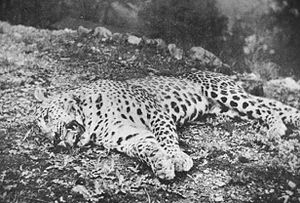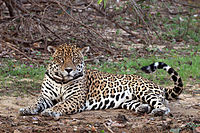Jaguar versus leopard
- A South American jaguar (Panthera onca) near Rio Negro
The jaguar (Panthera onca) and leopard (Panthera pardus) are two physically similar big cats of the genus Panthera,[1][2] between which comparisons have been made.[3][4][5][6]
Physical comparison[edit]
Coat[edit]

The jaguar coat[7] is different from that of leopard,[4][8] with large and dark rosettes, and the leopard with the smaller and more frequent rosettes.[9][10][4]
The rosettes on a jaguar's coat are larger,[5] fewer in number,[8] usually darker, and have thicker lines and small spots in the middle that the leopard lacks.[4][11]
The leopard's skin colour varies by climate and habitat from pale yellow to yellowish brown or golden. Leopards living in forests are darker than those in arid habitats.[4][9] Spots fade toward the white underbelly and the insides and lower parts of the legs. Rosettes are most prominent on the back, flanks and hindquarters.[10] The pattern of the rosettes is unique in each individual.[9][8] Rosettes are circular in East African leopard populations, and tend to be squarish in Southern African and larger in Asian leopard populations.[12]
Size[edit]
Jaguars are generally bigger in size compare to leopards,[4] with males, weighing more than 212 pounds (96 kg).[3][7] and larger males in South America have been recorded to weigh as much as 348 pounds (158 kg). The smallest South American females weigh about 79 pounds (36 kg).[4][7][8] North American jaguars are rather small, with those in the Chamela-Cuixmala Biosphere Reserve on the Mexican Pacific coast weighing just about 50 kilograms (110 lb).[13] The leopard's weight average is between 82 to 198 pounds (37 to 90 kg), with large males weighing up to at least 96 kg (212 lb).[14][3]
| Jaguars | Leopards | |
|---|---|---|
| Weight avarage | 123–212 pounds (56–96 kg)[15][7][8] up to 340 pounds (150 kg)[3][4][7][8] | 73–198 pounds (33–90 kg)[3][14] with a maximum weight of 215 pounds (98 kg).[8] |
| Height at shoulder | 25–30 inches (64–76 cm)[15][7][8] | Avarage for males is 24–28 inches (61–71 cm), while females are 22–25 inches (56–64 cm). |
| Head to tail length | 3.7 to 6.1 feet (1.1 to 1.9 m).[4][7][8] | 35 to 75 inches (89 to 191 cm).[4][5][9] |
| Tail | Jaguar has the shortest tail of any big cat, at 18 to 30 inches (46 to 76 cm) length.[7][8] | Tail is 24–39 inches (61–99 cm) long.[4][5][3] |
Bite force[edit]

The jaguar is known for its bite strength,[16][5] while the leopard has a smaller skull than jaguar,[lower-alpha 1] its bite strength is 'not compared' to that of the jaguar.[4][15] A jaguar bite can break the turtle's shell with a bite, it has the biggest bite strength among the big cats and it compares with the tiger as the cats with the srongest bite force.[16] The leopard bite strength can be deadly for the animals he hunts, but not as big as the jaguar.[8] Also, when the jaguar fought with the leopard,[3][5] he broke the leopard forhead skull with his bite.[4][17][16]
Distribution[edit]
The leopard inhabits European Russia,[18] Asia and Africa.[19] The jaguar inhabits North and South America.[20]
At present, the jaguar's range extends from southwestern United States and Mexico through Central America to South America, including much of Amazonian Brazil.[4][20] The countries included in this range are Argentina, Belize, Bolivia, Colombia, Costa Rica (particularly on the Osa Peninsula), Ecuador, French Guiana, Guatemala, Guyana, Honduras, Nicaragua, Panama, Paraguay, Peru, Suriname, and Venezuela. It is now locally extinct in El Salvador and Uruguay.[20]
The leopard has the largest distribution of all wild cats, occurring widely in Africa as well as eastern and southern Asia, although populations have shown a declining trend, and are fragmented outside of sub-Saharan Africa.[21] Within sub-Saharan Africa, the species is still numerous and even thriving in marginal habitats where other large cats have disappeared, although there is considerable potential for human-leopard conflict due to leopards preying on livestock.[3] Populations in North Africa may be extinct.[4][5] Data on their distribution in Asia are not consistent.[15]
Temperament[edit]
Both cats have fearsome reputations in their areas.[5] Leopard has more predators compare to jaguar,[9] and this might be one reason why leopard is small.[5][4][3]
- Like many cats, jaguars and leopards are solitary.[4] Both can create coalitions or pairs during mating seasons.[15][10]
- As smaller, it is agreed that the leopard is faster than the jaguar.[5][8]
- Both jaguar and leopard tend to prey on humans.[22][23]
Man-eating[edit]

Jaguar and leopards might prey on humans[15] espacially when their prey is rare or their are old.[8] Jaguar rarely[5] or do not prey on humans.[24][25] Leopard however attack humans[23] especially in the India subcontinent and Africa where their favorite prey is selected by predators like tigers and lions.[26] The leopard may be much smaller for humans, but much more dangerous compared to other big cats and it can be compared to the tiger with higher tend to prey on humans.[4][10]
Unlike leopards, jaguars very rarely attack humans.[8] However, jaguar attacks appear to be on the rise with increased human encroachment on their habitat and a decrease in prey populations.[25][27] Sometimes jaguars in captivity attack zookeepers.[24] In addition, it appears that attacks on humans had been more common in the past, at least after conquistadors arrived in the Americas, to the extent that the jaguar had a fearsome reputation in the Americas, akin to the lion and tiger in the Old World.[4][15] Nevertheless, even in those times, the jaguar's chief prey was the capybara, not the human, and Charles Darwin reported a saying of Native Americans that people would not have to fear the jaguar much, as long as capybaras were abundant.[6]
Fights[edit]
As they occurs in different continents, jaguar and leopard never met or fight together in wilderness.[4] The only fight between them was made in 20 century (1922) in captivity where jaguar break the forhead skull of leopard. After 10 minutes leopard die.[17] Though in the captivity fights are filmed, there is not enough evidence to see which of them could have won a fight.[5]
See also[edit]
- Animal-baiting
- Bull versus bear
- Comparison of cheetahs, jaguars and leopards
- Felidae
- Jaguar versus lion versus tiger
- Physical comparison of tigers and lions
- Tiger versus lion
Notes[edit]
- ↑ For more details, see Jaguar and leopard skull
References[edit]
- ↑ Kitchener, A. C.; Breitenmoser-Würsten, C.; Eizirik, E.; Gentry, A.; Werdelin, L.; Wilting, A.; Yamaguchi, N.; Abramov, A. V.; Christiansen, P.; Driscoll, C.; Duckworth, J. W.; Johnson, W.; Luo, S.-J.; Meijaard, E.; O’Donoghue, P.; Sanderson, J.; Seymour, K.; Bruford, M.; Groves, C.; Hoffmann, M.; Nowell, K.; Timmons, Z.; Tobe, S. (2017). "A revised taxonomy of the Felidae: The final report of the Cat Classification Task Force of the IUCN Cat Specialist Group" (PDF). Cat News (Special Issue 11). ISSN 1027-2992.
- ↑ Nowell, Kristin; Jackson, Peter (1996). Wild Cats: Status Survey and Conservation Action Plan (PDF). Gland, Switzerland: IUCN/SSC Cat Specialist Group. pp. 17–149. ISBN 2-8317-0045-0. Search this book on

- ↑ 3.0 3.1 3.2 3.3 3.4 3.5 3.6 3.7 3.8 Burnie, D.; Wilson, D. E., eds. (2001). Animal: The Definitive Visual Guide to the World's Wildlife. DK Adult, Dorling Kindersley. ISBN 978-0-7894-7764-4. Search this book on

- ↑ 4.00 4.01 4.02 4.03 4.04 4.05 4.06 4.07 4.08 4.09 4.10 4.11 4.12 4.13 4.14 4.15 4.16 4.17 4.18 4.19 4.20 D. Robert; A. Nicole. "Difference between jaguars and leopards". The Wildcat Sanctuary.
- ↑ 5.00 5.01 5.02 5.03 5.04 5.05 5.06 5.07 5.08 5.09 5.10 5.11 S. Smith; A. Smith; C. P. Anglee. "Can you spot the "difference" between them?". National Geographic.
- ↑ 6.0 6.1 John Hampden Porter (1894). Wild beasts; a study of the characters and habits of the elephant, lion, leopard, panther, jaguar, tiger, puma, wolf, and grizzly bear. pp. 76–256. Retrieved 2014-01-19. Search this book on

- ↑ 7.0 7.1 7.2 7.3 7.4 7.5 7.6 7.7 Boitani, Luigi (1984). Simon and Schuster's Guide to Mammals. Simon & Schuster. ISBN 0-671-43727-5. Search this book on

- ↑ 8.00 8.01 8.02 8.03 8.04 8.05 8.06 8.07 8.08 8.09 8.10 8.11 8.12 8.13 Nowak, R. M. (1999). Walker's Mammals of the World (6th ed.). Baltimore, USA: Johns Hopkins University Press. pp. 828–831. ISBN 978-0-8018-5789-8. Search this book on

- ↑ 9.0 9.1 9.2 9.3 9.4 Schütze, H. (2002). Field Guide to the Mammals of the Kruger National Park. Cape Town, South Africa: Struik Publishers. pp. 92–3. ISBN 978-1-86872-594-6. Search this book on

- ↑ 10.0 10.1 10.2 10.3 Menon, V. (2014). Indian Mammals: A Field Guide. Gurgaon, India: Hachette India. ISBN 978-93-5009-761-8. Search this book on

- ↑ "Jaguar (Panthera onca)". Our animals. Akron Zoo. Archived from the original on 2011-07-24. Retrieved 2006-08-11.
- ↑ Satunin, K. A. (1914), "Leopardus pardus ciscaucasicus", Conspectus Mammalium Imperii Rossici I. Tiflis, pp. 159–160
|access-date=requires|url=(help) - ↑ Nuanaez, R.; Miller, B.; Lindzey, F. (2000). "Food habits of jaguars and pumas in Jalisco, Mexico". Journal of Zoology. 252 (3): 373–379. doi:10.1111/j.1469-7998.2000.tb00632.x. Retrieved 2006-08-08.
- ↑ 14.0 14.1 Brain, C.K. (1983). The Hunter or the Hunted: An Introduction to African Cave Taphonomy. University of Chicago Press. ISBN 978-0-226-07090-2. Search this book on

- ↑ 15.0 15.1 15.2 15.3 15.4 15.5 15.6 15.7 "All about Jaguars: Ecology". Wildlife Conservation Society. Archived from the original on 2009-05-29. Retrieved 2006-08-11.
- ↑ 16.0 16.1 16.2 16.3 Smith, S., Jaguar's 'bite force'
|access-date=requires|url=(help) - ↑ 17.0 17.1 Smith, S., A fight (1922) between jaguar and leopard. Leopard dies after the match.
|access-date=requires|url=(help) - ↑ Lukarevsky, V.; Akkiev, M.; Askerov, E.; Agili, A.; Can, E.; Gurielidze, Z.; Kudaktin, A.; Malkhasyan, A.; Yarovenko, Y. (2007). "Status of the Leopard in the Caucasus" (PDF). Cat News (Special Issue 2): 15–21.
- ↑ Pirie, Tara J.; Thomas, Rebecca L.; Fellowes, Mark D.E. (2017-05-30). "Increasing game prices may alter farmers' behaviours towards leopards (Panthera pardus) and other carnivores in South Africa". PeerJ. 5: e3369. doi:10.7717/peerj.3369. ISSN 2167-8359.
- ↑ 20.0 20.1 20.2 Quigley, H.; Foster, R.; Petracca, L.; Payan, E.; Salom, R.; Harmsen, B. (2017). "Panthera onca". The IUCN Red List of Threatened Species. The IUCN. 2017: e.T15953A50658693. doi:10.2305/IUCN.UK.2017-3.RLTS.T15953A50658693.en. Retrieved 2 June 2018.
- ↑ Pirie, Tara J.; Thomas, Rebecca L.; Fellowes, Mark D.E. (2017-05-30). "Increasing game prices may alter farmers' behaviours towards leopards (Panthera pardus) and other carnivores in South Africa". PeerJ. 5: e3369. doi:10.7717/peerj.3369. ISSN 2167-8359.
- ↑ Th. Roseevelt. "Jaguar hunt by Th. Roseevelt". Bartleby.
- ↑ 23.0 23.1 23.2 J. Corbett. "Man-eaters: Leopard of Panar". DinoAnimals.
- ↑ 24.0 24.1 "Jaguar: The Western Hemisphere's Top Cat". Planeta. February 2008. Archived from the original on 21 August 2008. Retrieved 8 March 2009.
- ↑ 25.0 25.1 V. Iserson, K.; Francis, Adama M. (2015). "Jaguar Attack on a Child: Case Report and Literature Review". Western Journal of Emergency Medicine. 16 (2): 303–309. doi:10.5811/westjem.2015.1.24043. PMC 4380383. PMID 25834674.
- ↑ Skinner, J. D.; Chimimba, C. T. (2005). The Mammals of the Southern African Subregion (3rd ed.). Cambridge, UK: Cambridge University Press. pp. 397–401. ISBN 978-0-521-84418-5. Search this book on

- ↑ Dickerson, M. C. (1915). The American Museum Journal. p. 46. Search this book on

This article "Jaguar versus leopard" is from Wikipedia. The list of its authors can be seen in its historical and/or the page Edithistory:Jaguar versus leopard. Articles copied from Draft Namespace on Wikipedia could be seen on the Draft Namespace of Wikipedia and not main one.


